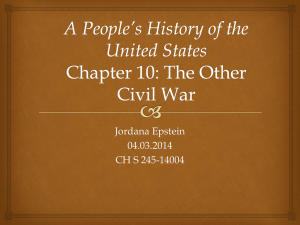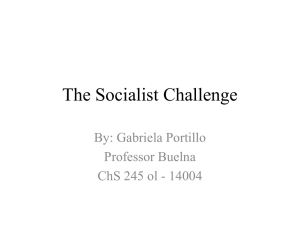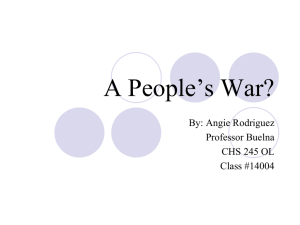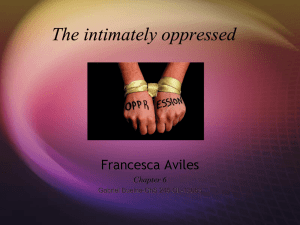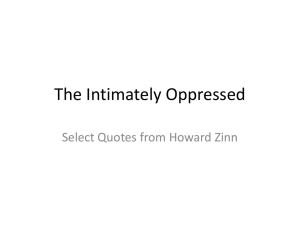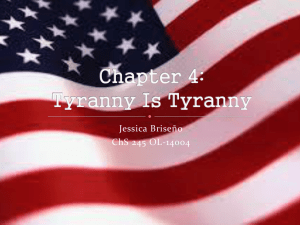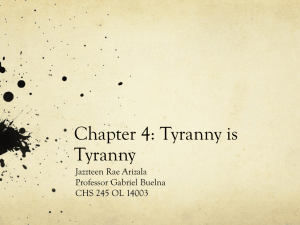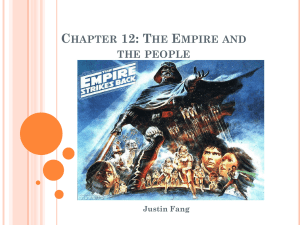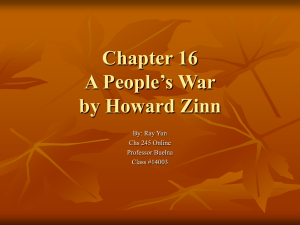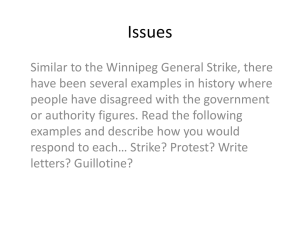A People*s History of The United States by Howard
advertisement
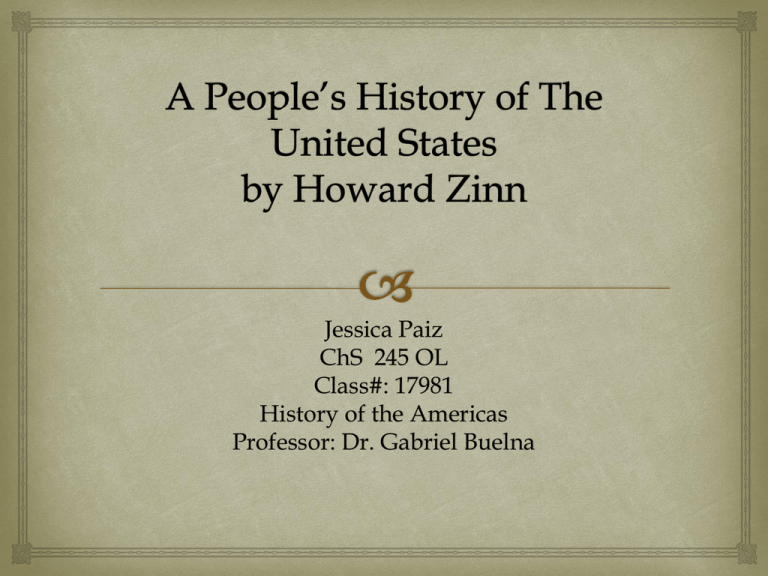
Jessica Paiz ChS 245 OL Class#: 17981 History of the Americas Professor: Dr. Gabriel Buelna Chapter 10: The Other Civil War Anti-Renter Movement Dorr Rebellion Jacksonian Democracy Flour Riot Lowell Girls Movement Shoemakers Strike Great Railroad Strike Anti-Rent Movement • • • • • • • • What? Anti-Rent Movement When? Started in the summer of 1839 Where? Hudson Valley/ New York Why? Tenants revolted because they wanted to prevent the landlords/owners from evicting them. Petitions for an anti-rent bill was put before legislature in 1845. It was signed by 25,000 tenants. In 1845, the Anti-Renters elected 14 members to the state legislature. Legislature voted to make illegal the selling of tenant property for nonpayment of rent. Dorr Rebellion Rhode Island 1841 Leader: Thomas Dorr, lawyer Movement for electoral reform because Dorr and working people who supported this rebellion wanted change in the system because they believed that it wasn’t fair that only owners of land could vote. There were even people who had the right to vote, because they owned property, supported this revolt. Zinn states was “a new constitution that had some reform because it still gave overrepresentation to the rural areas, limited the vote to property owners or those who paid a onedollar poll tax, and would let naturalized citizens vote only if they had $134 in real estate. (Zinn 214) Timeline of the Dorr Rebellion 1841- Electoral Reform supporters paraded in Providence and organized their own “People’s Convention”. Early 1842-invited votes on the constitution, held an unofficial election May 3, 1842- Dorr forces held an inauguration through Providence, Dorr led an attack on the state arsenal, governor ordered Dorr’s arrest, but he hid instead 1843-Law and Order group used intimidation to get out their vote, Dorr came out of hiding, was arrested, and served jail time. (Zinn 214-216) Jacksonian Democracy Andrew Jackson spoke for the common man which meant that he wanted to develop a better system to help those who need help (mostly for the lower and middle class) The author states that “but the tensions aroused by the developing system, the growing immigration, required that the government develop a mass base of support among whites. Jacksonian Democracy did just that” (Zinn 216). Achieve stability and control The only thing that seemed weird was that obviously blacks, Indians, women, and foreigners were clearly outside the consensus Andrew Jackson Flour Riot 1837-People went to riot because prices went up Prices of flour went from $5.62 to $12 a barrel which went up double the price. During this crisis there were 50,000 people out of work in NYC 200,000 were living in very horrible conditions. Not a lot of information is known on this riot because it has been ignored through history. Flour Riot cont’d Zinn writes about the flour riot that “Mr. Hart, an extensive flour dealer on commission, has now 53,000 barrels of flour in his store; let us go and offer him eight dollars a barrel, and if he does not take it…”(224) So they marched down to his business and “Barrels of flour, by dozens, and thrown in rapid succession from the windows…About one thousand bushels of wheat, and four or five hundred barrels of flour, were thus wantonly and foolishly as well as wickedly destroyed” (Zinn 225). Lowell Girls Movement Women demanded higher wages, new rules in factory that would benefit them and were fair This inequality created the United Tailoresses of New York, Factory Girl’s Association, and Female Labor Reform Association Women would work in the mills and lived in the dormitories. It seems very fair and helpful but the “dormitories became prisonlike, controlled by rules and regulation… were fed only a piece of bread and gravy”(Zinn 228). Lowell cont’d They protested against the mills because the weaving rooms were poorly lit, badly ventilated, their wages were terrible, worked from really morning and ended at night (Zinn 229) They protested and went on strike but when they didn’t have money they went back to work In total their were 140 strikes Shoemakers of Lynn, Massachusetts in 1857 1857- New England Shoemakers went on strike because many lost their jobs, prices went up, wages went down. Shoemakers were replaced by machines. 1860- The Mechanics Association made a meeting to discuss about the issues Shoemakers went on strike down the streets protesting and making sure that unfinished shoes would not be sent somewhere else to be finished. Shoemakers cont’d Thousands of men and women went on strikes and marched through cities to stop people from buying, selling and even from manufacturing. Great Railroad Strike 1877-Began cutting salaries and wages eg. ($1.75 for working 12 hours), scheming and profiteering by the railroad companies (Zinn 245) started strikes and violence. Railroad employees hated that they were paid a little and worked so many hours, but what they hated the most was that when they would get injured, like if their hands were chopped by machines, or coworkers would die from their injuries or incidents in the workplace, that the company ignored it and didn’t care and instead fired them knowing that they permanently couldn’t work anymore due to this. Many strikers died and others went to jail. “Workers determined to fight the wage cut, went on strike, uncoupled the engines, ran them into the roundhouse, and announced no more trains would leave Martinsburg until the 10% cut was canceled” (Zinn 245). Railroad cont’d “More than half the freight on the nation’s 75,000 miles of track had stopped running at the height of the strikes” (Zinn 251). One of the incidents that happened during this strike is that the angry strikers, “set engines, buildings, and equipment ablaze” (digital history website). Works Cited libcom.org/history/dorr-rebellion-1833-1849 www.digitalhistory.uh.edu/disp_textbook.cfm?smtI D=2&psid=3189 www.massaflcio.org/1860-showmakers-strike-lynn Zinn, Howard (2005). People’s History of the United States, Pennsylvania.
